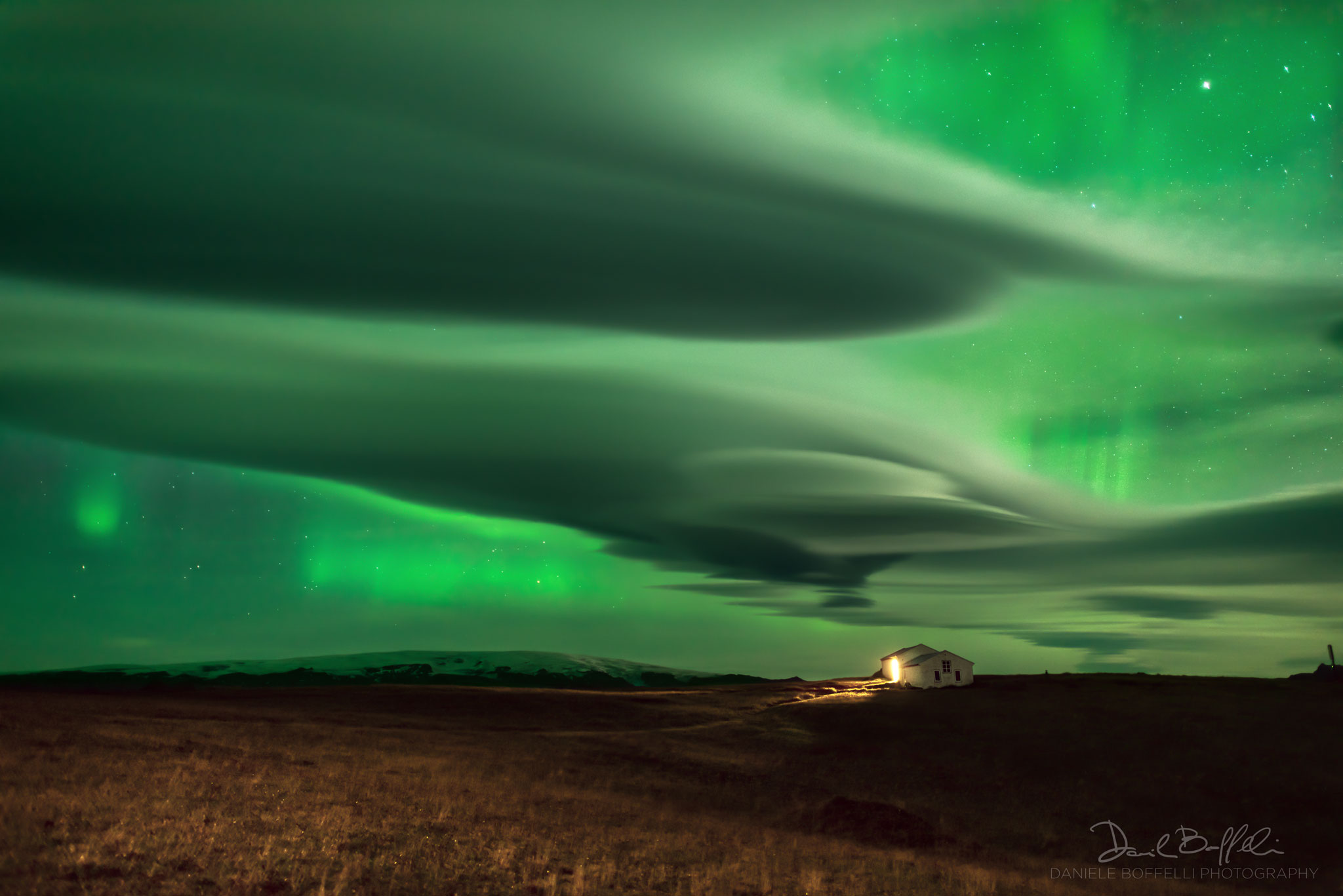30. May 2021
雲頂 ê 極光

探索宇宙1!逐工會揀一幅無仝款 ê 影像抑是相片,𤆬你熟似咱這个迷人 ê 宇宙,閣有專業天文學者2為你3解說4。
- 原始文章:Aurora over Clouds
- 影像來源 kah 版權:Daniele Boffelli
- APOD Instagram 嘛有:English, Farsi, Indonesian, Persian, or Portuguese
- 台文翻譯:An-Li Tsai (NCU)
[漢羅] 雲頂 ê 極光
極光一般來講會 tī 雲 ê 面頂出現。 極光 是 ùi 太陽噴出來 ê 快速運動粒子 碰著 地球磁層 產生 ê。 Tī 遐,踅 地球磁場 ê 帶電粒子,會碰著 地球大氣層 較懸所在 ê 原子 kah 分子。 像 酸素 原子,若是去予這款相碰激發了後,to̍h 會發出青色 ê 極光。 低層 ê 極光 會發生 tī 100 公里懸以上 ê 所在。 是講大部份 ê 雲干焦會出現 tī 10 公里懸以下 ê 所在。 這張 2015 年 tī 冰島 Dyrholaey 翕 ê 相片,to̍h 看會當清楚看著雲 kah 極光 ê 相對懸度。 Tī 遐, 有一位天文攝影師,為著欲翕著這个 媠甲親像一幅圖 ê 燈塔 面頂 ê 極光,決定忍受 強風 kah 彼陣 ê 烏陰天。 結果 tī 路 lih 煞翕著這張有搝長 透鏡雲 ê 相片。
[POJ] Hûn-téng ê Ke̍k-kng
Ke̍k-kng it-poaⁿ-lâi-kóng ē tī hûn ê bīn-téng chhut-hiān. Ke̍k-kng sī ùi Thài-iông phùn--chhut-lâi ê khoài-sok ūn-tōng lia̍p-chú pōng-tio̍h Tē-kiû chû-chân sán-seng ê. Tī hiah, se̍h Tē-kiû chû-tiûⁿ ê tài-tiān lia̍p-chú, ē pōng-tio̍h Tē-kiû tōa-khì-chân khah koân só͘-chāi ê goân-chú kah hun-chú. Chhiūⁿ sng-sò͘ goân-chú, nā-sī khì hō͘ chi̍t-khòaⁿ sio-pōng kek-hoat liáu-āu, to̍h ē hoat-chhut chheⁿ-sek ê ke̍k-kng. Kē-chân ê ke̍k-kng ē hoat-seng tī chi̍t-pah kong-lí koân í-siōng ê só͘-chāi. Sī-kóng tōa-pō͘-hūn ê hûn kan-na ē chhut-hiān tī cha̍p kong-lí koân í-hā ê só͘-chāi. Chit-tiuⁿ jī-khòng-it-ngó͘ nî tī Peng-tó Dyrholaey hip ê siòng-phìⁿ, to̍h ē-tàng chheng-chhó͘ khòaⁿ-tio̍h hûn kah ke̍k-kng ê siong-tùi koân-tō͘. Tī hiah, ū chi̍t-ūi thian-bûn liap-iáⁿ-su, ūi-tio̍h beh hip-tio̍h chit-ê súi-kah chhiⁿ-chhiūⁿ chi̍t-pak-tô͘ ê teng-thah bīn-téng ê ke̍k-kng, koat-tēng jím-siū kiông-hong kah hit-chūn ê o͘-im-thiⁿ. Kiat-kó tī lō͘--lih soah hip-tio̍h chit-tiuⁿ ū giú-tn̄g thàu-kiàⁿ-hûn ê siòng-phìⁿ.
[KIP] Hûn-tíng ê Ki̍k-kng
Ki̍k-kng it-puann-lâi-kóng ē tī hûn ê bīn-tíng tshut-hiān. Ki̍k-kng sī uì Thài-iông phùn--tshut-lâi ê khuài-sok ūn-tōng lia̍p-tsú pōng-tio̍h Tē-kiû tsû-tsân sán-sing ê. Tī hiah, se̍h Tē-kiû tsû-tiûnn ê tài-tiān lia̍p-tsú, ē pōng-tio̍h Tē-kîu tuā-khì-tsân khah kuân sóo-tsāi ê guân-tsú kah hun-tsú. Tshiūnn sng-sòo guân-tsú, nā-sī khì hōo tsi̍t-khuànn sio-pōng kik-huat liáu-āu, to̍h ē huat-tshut tshenn-sik ê ki̍k-kng. Kē-tsân ê ki̍k-kng ē huat-sing tī tsi̍t-pah kong-lí kuân í-siōng ê sóo-tsāi. Sī-kóng tuā-pōo-hūn ê hûn kan-na ē tshut-hiān tī tsa̍p kong-lí kuân í-hā ê sóo-tsāi. Tsit-tiunn jī-khòng-it-ngóo nî tī Ping-tó Dyrholaey hip ê siòng-phìnn, to̍h ē-tàng tshing-tshóo khuànn-tio̍h hûn kah ki̍k-kng ê siong-tuì kuân-tōo. Tī hiah, ū tsi̍t-uī thian-bûn liap-iánn-su, uī-tio̍h beh hip-tio̍h tsit-ê suí-kah tshinn-tshiūnn tsi̍t-pak-tôo ê ting-thah bīn-tíng ê ki̍k-kng, kuat-tīng jím-siū kiông-hong kah hit-tsūn ê oo-im-thinn. Kiat-kó tī lōo--lih suah hip-tio̍h tsit-tiunn ū giú-tn̄g thàu-kiànn-hûn ê siòng-phìnn.
[English] Aurora over Clouds
Auroras usually occur high above the clouds. The auroral glow is created when fast-moving particles ejected from the Sun impact the Earth's magnetosphere, from which charged particles spiral along the Earth's magnetic field to strike atoms and molecules high in the Earth's atmosphere. An oxygen atom, for example, will glow in the green light commonly emitted by an aurora after being energized by such a collision. The lowest part of an aurora will typically occur about 100 kilometers up, while most clouds exist only below about 10 kilometers. The relative heights of clouds and auroras are shown clearly in the featured picture in 2015 from Dyrholaey, Iceland. There, a determined astrophotographer withstood high winds and initially overcast skies in an attempt to capture aurora over a picturesque lighthouse, only to take, by chance, the featured picture including elongated lenticular clouds, along the way.
詞彙學習
| 漢羅 | POJ | KIP | 華語 | English |
|---|---|---|---|---|
| 極光 | ke̍k-kng | ki̍k-kng | 極光 | aurora |
| 磁層 | chû-chân | tsû-tsân | 磁層 | magnetosphere |
| 酸素 | sng-sò͘ | sng-sòo | 氧 | Oxygen |
| 透鏡雲 | thàu-kiàⁿ-hûn | thàu-kiànn-hûn | 透鏡雲 | lenticular clouds |